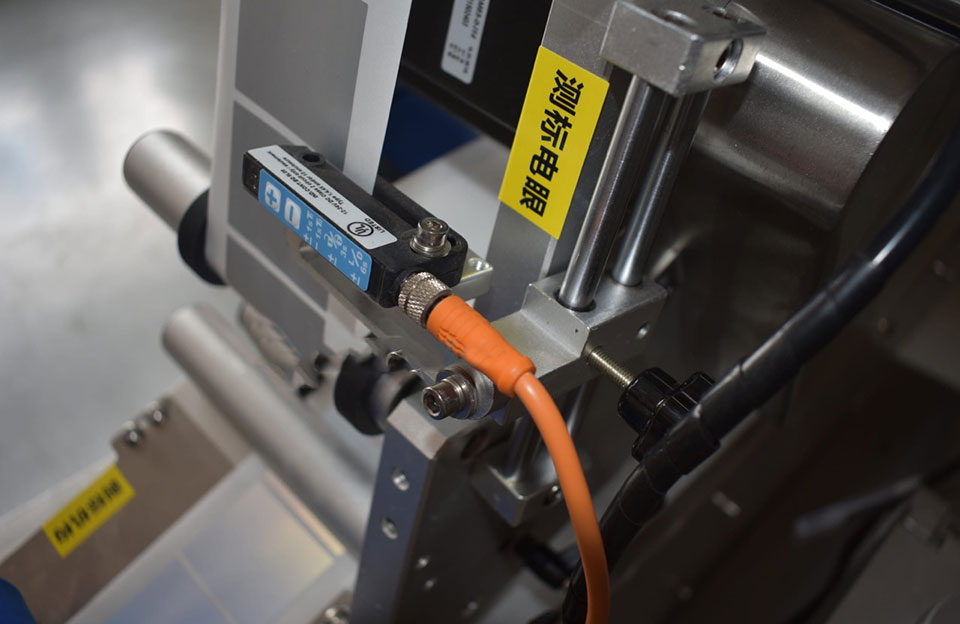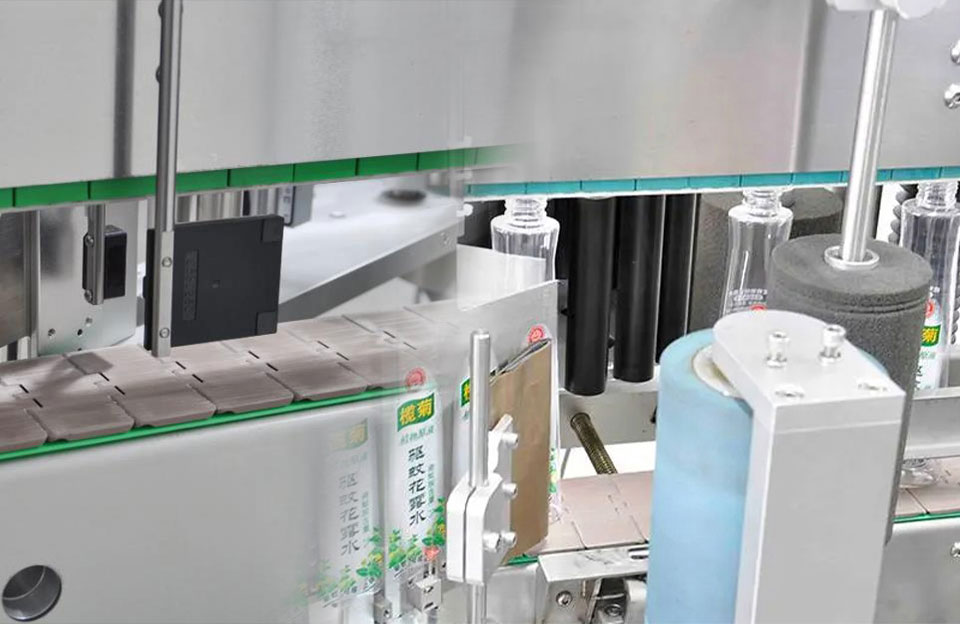A label sensor, or labeling machine sensor, is a specialized type designed to detect and interpret labels or markings on various objects or surfaces. These labels can include barcodes, QR codes, RFID tags, printed text, symbols, and other visual identifiers. Label sensors are commonly used in industrial, manufacturing, logistics, and retail settings to automate inventory tracking, quality control, product sorting, and more.
Key Components of Label Sensor
The sensor emits electromagnetic radiation (such as light or radio waves) onto the labeled surface and then analyzes the reflected signals. The sensor processes the information obtained from the labels to provide meaningful data for further actions. The key components of a label sensor typically include:
- Emitter: This component produces electromagnetic radiation directed toward the labeled surface. In the case of a barcode or QR code sensor, it could be an LED or laser light source.
- Receiver: The receiver collects the reflected signals from the labeled surface. This component is sensitive to the specific type of radiation used (light, radio waves, etc.) and is responsible for capturing the information contained in the labels.
- Decoder: The decoder interprets the collected data from the labels. For instance, in the case of barcode sensors, the decoder processes the pattern of bars and spaces to extract the encoded information.
- Processing Unit: This part of the sensor system analyzes and processes the decoded data, making it ready for integration into other systems or taking actions based on the information obtained from the labels.
- Output Interface: The label sensor often provides an output, such as digital signals or data packets, that can be used by connected systems or devices to trigger appropriate actions. For example, in an inventory management system, the label sensor’s output might signal the update of stock levels in a database.
Different Types of Label Sensor
Label sensors are specialized devices that detect, verify, or read labels on products, packaging, or objects. They are widely used in manufacturing, logistics, retail, and other industries. Here are some different types of label sensors:
- Optical Label Sensors: These sensors use light-based technology to detect labels. They can sense variations in light intensity or reflectivity caused by the presence or absence of labels on objects. Optical label sensors are commonly used in industries where accurate label positioning is critical, such as packaging and labeling machines.
- Ultrasonic Label Sensors: Ultrasonic sensors use sound waves to detect objects, including labels. They emit ultrasonic pulses and measure the time it takes for the pulses to bounce back after hitting an object. This technology is useful for detecting labels on irregular surfaces or in environments where optical methods might be hindered.
- Capacitive Label Sensors: Capacitive sensors detect changes in capacitance (the ability to store an electric charge) caused by the presence or absence of labels. They are sensitive to variations in the dielectric properties of materials, which can change when labels are applied.
- RFID Label Sensors: Radio-Frequency Identification (RFID) label sensors are used to read RFID tags or labels. These tags contain electronic information that RFID sensors can wirelessly read. RFID technology is often used for inventory management, supply chain tracking, and access control.
- Barcode Scanners: While not “sensors” in the traditional sense, barcode scanners read information from printed barcodes on labels. They use lasers or cameras to scan the barcode and translate it into readable data. Barcode scanners are extensively used in retail, inventory management, and point-of-sale systems.
- Inductive Label Sensors: Inductive sensors use electromagnetic fields to detect metallic objects, including labels with metallic components. They are often used in applications where labels have metallic foil, and they can reliably detect the presence of labels even in challenging environments.
- Color Mark Sensors: These sensors detect labels or marks based on color or contrast. They are especially useful when labels have distinct colors or patterns that need identification.
- Contact Label Sensors: These sensors touch the label’s surface to detect its presence. They are commonly used for applications with labels on irregular surfaces or in situations where non-contact methods might not work well.
- Print Registration Sensors: These sensors ensure accurate label alignment during the printing process. They detect registration marks or reference points on the label to ensure the printing is correctly positioned.

Optical Label Sensor
The Key Function of Label Sensor during Label Application
The key function of a label sensor during label application is to ensure the accurate and precise placement of labels on products, packages, or objects. Label sensors play a critical role in various industries, including manufacturing, packaging, logistics, and retail, where proper labeling is essential for product identification, branding, traceability, and compliance. Here are how many functions of the label sensor during label application:
- Label Detection: Labeling machine sensors detect the presence or absence of labels on the intended objects or surfaces. This detection capability ensures that labels are properly applied, and missing or misalignments are promptly identified.
- Label Verification: Labeling machine sensors can verify that the correct label is applied to each product. This is particularly important to prevent mix-ups and ensure that products are accurately labeled with the right position.
- Alignment and Positioning: Labeling machine sensors ensure proper alignment and positioning of labels on products or packaging materials. They can detect if labels are applied off-center, skewed, or crooked, allowing adjustments to be made to ensure visual consistency and aesthetic appeal.
- Quality Control: Label sensors contribute to quality control by flagging any defective labels, such as those with printing errors, damaged barcode or QR code labels, or labels that are torn or wrinkled during application.
- Automation and Efficiency: Label sensors are often integrated into labeling machines and automated production lines. Their ability to accurately detect and verify labels allows for efficient and consistent labeling processes, reducing the need for manual intervention and minimizing production bottlenecks.
- Waste Reduction: By detecting misaligned or defective labels early in the process, label sensors help reduce material waste. Labels that would otherwise be discarded due to errors can be corrected or reprinted before application.
- Data Collection: Some label sensors, such as RFID or barcode sensors, can capture data encoded in labels. This data can be used for inventory management, supply chain tracking, and other business processes, enhancing overall operational efficiency.
- Regulatory Compliance: Accurate labeling is essential for compliance in industries with strict regulations, such as food and pharmaceuticals. Label sensors help ensure products are correctly labeled with the required information, such as ingredients, nutritional information, and safety warnings.
- Consistency and Branding: Label sensors contribute to maintaining consistent branding across products. Ensuring labels are aligned and placed consistently helps create a professional appearance that aligns with a company’s brand identity.
Future Development of Label Sensor Technology
- Advanced Optical Imaging: Labeling machine sensors could incorporate more advanced optical imaging techniques, such as hyperspectral or 3D imaging, to enhance label detection accuracy and quality control. These techniques could enable sensors to detect finer details, differentiate between similar labels, and identify defects that are not easily visible with conventional sensors.
- Machine Learning and AI Integration: Labeling machine sensor technology could increasingly incorporate machine learning and artificial intelligence algorithms. This integration could enable label sensors to adapt and self-optimize based on historical data, improving detection accuracy and reducing false positives/negatives.
- Edge Computing: Label sensors might include edge computing capabilities, allowing data processing and analysis to occur directly within the sensor device. This could lead to faster response times and reduced reliance on centralized processing systems.
- Wireless Connectivity: Future label sensors could have built-in wireless connectivity, enabling real-time communication with other devices and systems. This could enhance data sharing, remote monitoring, and coordination within manufacturing and logistics processes.
- Flexible Substrate Compatibility: Labeling machine sensors could be designed to work with a wider range of label substrates, including flexible and curved surfaces. This could be crucial in industries like healthcare, where labels are applied to medical devices with complex shapes.
- Multi-modal Sensors: Sensors capable of detecting multiple attributes simultaneously, such as label presence, alignment, and color, could become more common. These multi-modal sensors would offer a comprehensive label detection and quality control solution.
- Energy Efficiency: Advancements in energy-efficient technologies could lead to label sensors that consume less power while maintaining high performance. This would be particularly important for applications where sensors must operate for extended periods.
- Augmented Reality Integration: Label sensors could be integrated with augmented reality (AR) systems in fields such as maintenance and repair. Technicians wearing AR glasses could receive real-time feedback and guidance for label application or inspection.
- Hybrid Sensor Systems: Future label sensing solutions might combine the strengths of multiple sensor technologies (such as optical, RFID, and ultrasonic) to achieve more accurate and versatile label detection across various scenarios.
- Security Features: Label sensors could enhance security and authentication measures, particularly in industries where product counterfeiting is a concern. Sensors might work in conjunction with advanced label materials that include authentication features.
- Sustainability Considerations: Label sensor technology might shift towards more sustainable materials and manufacturing processes as environmental concerns grow. Sensors could be designed for easier recycling and reduced environmental impact.
- User-Friendly Interfaces: The user interfaces of label sensors could become more intuitive and user-friendly, allowing operators to set up, calibrate, and monitor sensors with ease.
Conclusion
Label sensors play a pivotal role in various industries by ensuring accurate labeling, improving automation, enhancing quality control, enabling efficient data collection, and contributing to overall operational excellence. Their importance is underscored by their ability to streamline processes, enhance traceability, and support compliance with regulations and standards.


